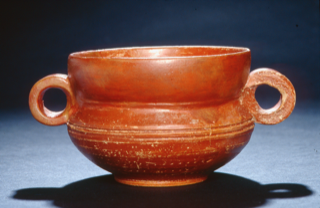
Collections:
Description:
Material from the Hellenistic site Jebel Khalid
Introduction by G.W. Clarke
Jebel Khalid is a limestone mesa of some 50ha on the west bank of the Euphrates, overlooking a strategic crossing point of the river where it narrows. For just over a quarter of a century, a combined archaeology team from the University of Melbourne and the Australian National University excavated the site, starting from its original discovery as a Hellenistic city (by Graeme Clarke) and surveys in 1984 and 1985. The excavation program was cut short in 2010 by political events. For much of this time the Directors have been Dr Heather Jackson FSA FAHA (UMelb) and Professor Graeme Clarke FSA FAHA (ANU). Their teams have been drawn from all around Australia as well as internationally—full details of the personnel involved over these years are to be found on the website http://jebelkhalid.arts.unimelb.edu.au/
Survey and excavation have revealed a hitherto unknown Hellenistic city, established in the third century BC as a military colony under the Seleucid dynasty following the conquest of Alexander (the Great). It was substantially abandoned by the middle of the first century BC with the collapse of that Seleucid dynasty. The city was carefully laid out on a Hippodamian grid, with streets running strictly north/south and east/west. It covered some 30ha of built environment, with 3.4 km of protective city-walling with 30 bastions and towers and a separate walled Acropolis.
Such cities established under the Seleucids are largely unknown to us, being for the most part overlaid by subsequent centuries of occupation. The only other comparable site is Ai Khartoum on the Oxus in Northern Afghanistan, but that site is not only currently inaccessible and has been subject to severe robbing but it was destroyed by the mid-second century BC. At Jebel Khalid, by contrast, the Governor’s Palace, the Temple, Palaestra, and the fully-excavated housing insula (unique among Seleucid sites) have allowed us to discover for the first time what everyday life was like in such a settlement over its two-and-a-half centuries of occupation. It has cast a light on an otherwise unknown period of history.
G.W. Clarke, P.J. O’Connor, L. Crewe et al., Jebel Khalid on the Euphrates, vol. 1: Report on Excavations 1986-1996. Mediterranean Archaeology Supplement 5 (Sydney, 2002).
H. Jackson, Jebel Khalid on the Euphrates, vol. 2: The Terracotta Figurines. Mediterranean Archaeology Supplement 6 (Sydney, 2006).
H. Jackson and J. Tidmarsh, Jebel Khalid on the Euphrates, vol. 3: The Pottery. Mediterranean Archaeology Supplement 7 (Sydney, 2011).
H. Jackson, Jebel Khalid on the Euphrates, vol. 4: The Housing Insula. Mediterranean Archaeology Supplement 9 (Sydney, 2014).
G.W. Clarke, H. Jackson, C.E.V. Nixon et al., Jebel Khalid on the Euphrates, vol. 5: Report on Excavations 2000-2010. Mediterranean Archaeology Supplement 10 (Sydney, 2016).
K. M. Wesselingh, Jebel Khalid on the Euphrates, vol. 6: A Zooarchaeological Analysis. Mediterranean Archaeology Supplement 11 (Sydney, 2018).